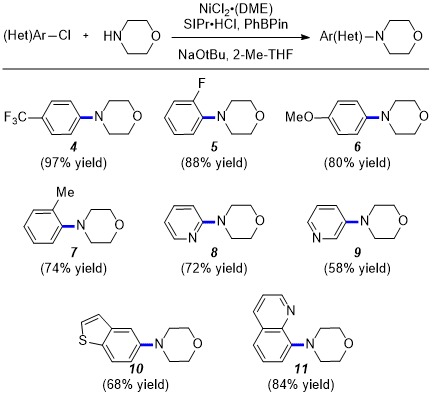Org. Synth. 2024, 101, 150-163
DOI: 10.15227/orgsyn.101.0150
Nickel-catalyzed Amination of Aryl Chlorides
Submitted by Zachary G. Walters, Daniel W. Turner, and Neil K. Garg*
1Checked by Prashansa B. Kannangara and M. Kevin Brown
1. Procedure (Note 1)
4-(Naphthalen-1-yl)morpholine (3). A single-necked (24/40 joint) 250 mL round-bottomed flask is equipped with a Teflon-coated magnetic stir bar (2 cm, octagon shaped). The apparatus is flame-dried under reduced pressure and cooled to 23 ℃ under a nitrogen atmosphere. The flask is then capped with a rubber septum (Figure 1A) and placed under positive pressure of nitrogen using a nitrogen inlet. The flask is then charged with 1,3-bis(2,6-diisopropylphenyl)imidazolidinium choride (0.361 g, 0.850 mmol, 6.00 mol%) (Note 2), phenylboronic acid pinacol ester (1.00 g, 4.90 mmol, 35.0 mol%) (Note 3), nickel(II) chloride ethylene glycol dimethyl ether complex (95.0 mg, 0.420 mmol, 3.00 mol%) (Note 4) and sodium tert-butoxide (3.06 g, 31.6 mmol, 2.26 equiv) (Note 5), each in one portion (Figure 1B). For each addition, the septum with the nitrogen inlet is removed and subsequently placed back onto the flask. A vent needle (18 gauge) is then added to the septum, while maintaining the flask under positive pressure of nitrogen. To the flask is then added 2-methyltetrahydrofuran (70.0 mL) via syringe transfer over 1 min (Note 6), followed by morpholine (2) (2.17 mL, 25.2 mmol, 1.80 equiv) (Notes 7 and 8) via syringe transfer over 1 min, and 1-chloronaphthalene (1) (1.91 mL, 14.0 mmol, 1.00 equiv) over 1 min (Note 9) via syringe transfer (Figure 1C). The resulting tan mixture is then stirred at 900 rpm for one min at 23 ℃. The vent needle is removed, and the mixture is stirred for one h at 23 ℃ under nitrogen atmosphere, yielding a heterogenous brown solution.
Stirring is ceased and the septum removed. The flask is quickly equipped with a flame-dried water jacketed condenser (2 cm OD x 20 cm tall), sealed with a rubber septum, and again placed under positive pressure of nitrogen using a nitrogen inlet and a vent needle, purging with nitrogen for one min.
Figure 1. (A) Set-up of glassware for the reaction; (B) Solid reagents before adding liquid reagents; (C) Reaction setup with all liquid reagents; (D) Reaction set-up at beginning of heating; (E) Reaction mixture after 3 hours at 80 ℃ (photos provided by authors)
The vent needle is then removed, and the water line to the condenser is turned on, maintaining a steady flow of water through the condenser throughout the remainder of the reaction (Figure 1D). The apparatus is then lowered into an oil bath, stirring is resumed at 900 rpm, then the bath is heated to 80 ℃. The solution is stirred for 3 h at 80 ℃ (Note 10) (Figure 1E).
The apparatus is removed from the oil bath and allowed to cool to 23 ℃. The reflux condenser is then detached from the round-bottomed flask, and the stir bar is removed with a magnetic stir bar retriever. The reaction mixture is passed through a 40 g silica gel (Note 11) pad contained in a 150 mL fritted funnel (Note 12) (Figure 2A). The filter cake is washed with 150 mL EtOAc (Note 13) (Figure 2). The top of the silica pad is occasionally scraped with a spatula to facilitate filtration and avoid clogging. The filtrate is then concentrated under reduced pressure via rotary evaporator (30 ℃ bath, 50 mmHg). The flask is then placed under high vacuum (<1.0 mmHg) for 5 min to yield the crude product as an orange oil (Figure 2B).
Figure 2. (A) Filtration Apparatus; (B) Crude product (photos provided by authors)
A silica gel column (6 cm OD x 18 cm tall) is prepared with 180 g silica gel (Note 11) wetted with 300 mL of hexanes (Note 14). The crude product is then dissolved in 5 mL methylene chloride (Note 15) and loaded onto the column, rinsing the flask containing the crude material 3 times with 3 mL methylene chloride, then loading that solvent onto the column (Figure 3A). The column is then topped with a 2 cm high layer of sand. The column is eluted with 19:1 hexanes:ethyl acetate. Fraction collection (16 x 100 mm culture tubes, 13 mL fractions) begins immediately. The eluate containing the product (Note 16) is concentrated under reduced pressure via a rotary evaporator (30 ℃ bath, 350 mmHg to 50 mmHg), then under high vacuum (<1 mmHg) for 1 h affording 4-(naphthalen-1-yl)morpholine (3) (2.77 g, 93%) as a flaky off-white to light pink solid (Figure 3B) (Notes 17, 18, and 19).
Figure 3. (A) Column loaded with crude material; (B) Pure product. (photos provided by authors)
2. Notes
1. Prior to performing each reaction, a thorough hazard analysis and risk assessment should be carried out with regard to each chemical substance and experimental operation on the scale planned and in the context of the laboratory where the procedures will be carried out. Guidelines for carrying out risk assessments and for analyzing the hazards associated with chemicals can be found in references such as Chapter 4 of "Prudent Practices in the Laboratory" (The National Academies Press, Washington, D.C., 2011; the full text can be accessed free of charge at
https://www.nap.edu/catalog/12654/prudent-practices-in-the-laboratory-handling-and-management-of-chemical. See also "Identifying and Evaluating Hazards in Research Laboratories" (American Chemical Society, 2015) which is available via the associated website "Hazard Assessment in Research Laboratories" at
https://www.acs.org/content/acs/en/about/governance/committees/chemicalsafety/hazard-assessment.html. In the case of this procedure, the risk assessment should include (but not necessarily be limited to) an evaluation of the potential hazards associated with
1,3-bis(2,6-diisopropylphenyl)imidazolidinium choride,
phenylboronic acid pinacol ester,
nickel(II) chloride ethylene glycol dimethyl ether complex,
sodium tert-butoxide,
2-methyltetrahydrofuran,
morpholine (
2),
1-chloronaphthalene (
1), silica gel,
hexanes,
ethyl acetate, and
methylene chloride.
2.
1,3-Bis(2,6-diisopropylphenyl)imidazolidinium choride (97%) was purchased from Sigma-Aldrich and used as received.
3.
Phenylboronic acid pinacol ester (98%) was purchased from Oakwood and used as received.
4.
Nickel(II) chloride ethylene glycol dimethyl ether complex (98%) was purchased from Sigma-Aldrich and used as received.
5.
Sodium tert-butoxide (97%) was purchased from Sigma-Aldrich and used as received.
6.
2-Methyltetrahydrofuran (99%, extra dry, AcroSeal) was purchased from Acros Organics and used as received.
7.
Morpholine (ACS reagent, >99%) was purchased from Sigma-Aldrich and freshly distilled over CaH
2 using a short-path distillation apparatus prior to use.
8.
Sodium tert-butoxide and
morpholine must be used in excess for optimal yield. When the reaction is performed with less equivalents of these reactants, yield is drastically lowered.
9.
1-Chloronaphthalene (technical grade, >90%) was purchased from Sigma-Aldrich and used as received.
10. The progress of the reaction is monitored by TLC analysis on silica gel with 49:1
hexanes:
ethyl acetate used as an eluent. The plate is visualized using a UV lamp (254 nm). The aryl chloride starting material (
1) has R
f 0.63 and the
morpholine product (
3) has R
f 0.15 (Figure 4), with a byproduct at R
f 0.50 and R
f 0.10.
Figure 4. TLC of the crude reaction mixture after 3 h (SM= chloride starting material, CO = co-spot of SM and RX, RX = reaction mixture). Circled spots highlight consumption of starting material (photo provided by authors)
11. Silica gel (SiliaFlash P60, particle size 0.040-0.063 nm) was purchased from SiliCycle, Inc. and used as received.
12. Filtration was done using a medium porosity Quark Glass fritted funnel (130 mL capacity) under vacuum. Silica gel was suspended in 30 mL
EtOAc, stirred, then packed under vacuum.
13.
Ethyl acetate (99.5%) was purchased from Fischer Scientific and used as received.
14.
Hexanes (98.5%) was purchased from Fischer Scientific and used as received.
15.
Methylene chloride (99.9%) was purchased from Fischer Chemical and used as received.
16. Fractions containing desired product were identified via TLC. Using a solvent system of 9:1
hexanes:
ethyl acetate, compound
3 has a R
f = 0.40. Fractions 61-111 contained the desired product and were collected in a 2 L round-bottomed flask. Each fraction was rinsed with
methylene chloride (2 x 1 mL) to ensure quantitative transfer.
Figure 5. Fractions collected (photo provided by authors)
17. The purity of product
3 obtained from chromatography was determined to be 99.8% by qNMR
pdf using
dibromomethane (Sigma-Aldrich, 98%) as the internal standard.
18. The product was characterized as follows:
1H NMR
pdf (500 MHz, CDCl
3) δ: 8.27 - 8.16 (m, 1H), 7.84 (dd,
J = 7.5, 2.1 Hz, 1H), 7.58 (d,
J = 8.2 Hz, 1H), 7.53 - 7.45 (m, 2H), 7.42 (t, J = 7.8 Hz, 1H), 7.10 (dd,
J = 7.5, 1.1 Hz, 1H), 4.02 - 3.96 (m, 4H), 3.13 (t,
J = 4.5 Hz, 4H);
13C NMR
pdf (125 MHz, CDCl
3) δ: 149.6, 134.9, 128.94, 128.6, 126.0, 126.0, 125.6, 124.0, 123.5, 114.8, 67.6, 53.7.; IR (neat): 2942, 2816, 1700, 1589, 1576, 1454, 1396, 1258, 1222, 1112, 1012, 918, 851, 775 cm
-1. HRMS-ESI (
m/z) [M + H]
+ calc for C
14H
15NO
+, 214.1226; found, 214.1228; mp 79.6 - 80.2 ℃.
19. A duplicate reaction performed by the checkers on the identical scale provided 2.84 g (95%) of the amination product (
3). The purity of the duplicate run was determined to be 99.8% by qNMR using
dibromomethane (Sigma-Aldrich, 98%) as the internal standard.
Working with Hazardous Chemicals
The procedures in
Organic Syntheses are intended for use only by persons with proper training in experimental organic chemistry. All hazardous materials should be handled using the standard procedures for work with chemicals described in references such as "Prudent Practices in the Laboratory" (The National Academies Press, Washington, D.C., 2011; the full text can be accessed free of charge at
http://www.nap.edu/catalog.php?record_id=12654). All chemical waste should be disposed of in accordance with local regulations. For general guidelines for the management of chemical waste, see Chapter 8 of Prudent Practices.
In some articles in Organic Syntheses, chemical-specific hazards are highlighted in red "Caution Notes" within a procedure. It is important to recognize that the absence of a caution note does not imply that no significant hazards are associated with the chemicals involved in that procedure. Prior to performing a reaction, a thorough risk assessment should be carried out that includes a review of the potential hazards associated with each chemical and experimental operation on the scale that is planned for the procedure. Guidelines for carrying out a risk assessment and for analyzing the hazards associated with chemicals can be found in Chapter 4 of Prudent Practices.
The procedures described in Organic Syntheses are provided as published and are conducted at one's own risk. Organic Syntheses, Inc., its Editors, and its Board of Directors do not warrant or guarantee the safety of individuals using these procedures and hereby disclaim any liability for any injuries or damages claimed to have resulted from or related in any way to the procedures herein.
3. Discussion
This procedure provides an efficient and scalable amination of aryl chlorides using an air-stable pre-catalyst in 2-methyltetrahydrofuran (2-MeTHF), a green solvent.
2 An extremely important field in organic chemistry is the formation of carbon-nitrogen (C-N) bonds. Buchwald-Hartwig type aminations are important catalytic reactions to form C-N bonds, allowing rapid access to aminated arenes, which are commonly seen in pharmaceutical candidates.
3 The utility of this reaction is exemplified by its prevalence in medicinal chemistry, ranking favorably amongst the top twenty most frequently used reactions.
4 However, common procedures often employ the use of transition metal pre-catalysts that are air sensitive or expensive, thus limiting their applicability. Procedures have therefore been developed to use less expensive, air stable transition metals. Nickel has been particularly enabling in these reactions, due to its tolerance of a variety of functional groups and electrophiles, its relatively low cost, and high natural abundance when compared to other popular metals to catalyze aminations.
5,6,7,8 Additionally, methods have been reported to use an added reductant to allow the use of air-stable Ni(II) pre-catalysts via
in-situ reduction to Ni(0).
9,10Our laboratory developed a user-friendly procedure to achieve the amination of aryl chlorides and aryl sulfamates.
10 The reaction has been specifically optimized to take place in 2-MeTHF, a green solvent, as well as using an inexpensive and commercially available NHC ligand, 1,3-bis(2,6-diisopropylphenyl)imidazolidinium chloride. Additionally, the reaction uses air stable nickel(II) chloride ethylene glycol dimethyl ether complex as the pre-catalyst, phenylboronic acid pinacol ester as a mild reductant, and sodium
tert-butoxide as base. A variety of aminated arenes can be formed in good yields using this procedure (Figure 6). These include electron poor (
4,
5), electron rich (
6,
7), and heterocyclic substrates (
8,
9,
10,
11), all in moderate to high yield. These substrates also display substitution at varying positions, including substrates with substituents at the
ortho position, indicating some tolerance for steric bulk, leading to products such as
5,
7, and
11.

Figure 6. Selected scope of amination of aryl chlorides
Under these same conditions, aryl sulfamates are also competent electrophiles, allowing access to aminated products from derivatized phenol compounds (Figure 7). Aryl sulfamates are attractive as electrophiles because of their ease of synthesis, stability, and directing ability for functionalization of arenes.
6,11 Notably, yields of the reaction using aryl sulfamates are generally comparable compared to those seen if aryl chlorides are used. Exemplary products obtained from sulfamate amination are
4-
9 and
12-
14.
Figure 7. Selected scope for the amination of aryl sulfamates
A variety of different amines can also be utilized in this transformation, as we depict for aryl sulfamate cross-couplings (Figure 8). Reaction with aryl sulfamates showed tolerance of pyrrolidines (15), alkyl amines (16), sterically hindered anilines (17), as well as functionalized piperazines (18), allowing rapid access to aryl amines.
Figure 8. Selected scope of amine nucleophiles
In summary, this methodology provides an approach to access aminated aromatic compounds via the use of an air-stable Ni(II) precatalyst and 2-methyltetrahydrofuran as solvent. This reaction functions similarly with aryl chlorides and aryl sulfamates and is tolerant of electron-rich and electron-poor arenes, as well as several different heterocycles. This methodology, as well as related advances,
12 allows access to a wide array of scaffolds with important implications in medicinal chemistry.
Appendix
Chemical Abstracts Nomenclature (Registry Number)
1,3-Bis(2,6-diisopropylphenyl)imidazolidinium chloride (258278-25-0)
Phenylboronic acid pinacol ester (24388-23-6)
Nickel(II) chloride ethylene glycol dimethyl ether complex (29046-78-4)
Sodium tert-butoxide (865-48-5)
Morpholine (2) (110-91-8)
1-Chloronaphthalene (1) (90-13-1)

|
Zachary Walters was born and raised in Battle Ground, Washington. In 2022, he received his B.S. in Chemistry from Boise State University, where he carried out research under the direction of Professor Don L. Warner. In 2022, he began his graduate studies at the University of California, Los Angeles, where he is currently a second-year graduate student in Professor Neil K. Garg's laboratory. His studies focus on both total synthesis and methodology development. |

|
Daniel Turner was born and raised in San Diego, California. In 2022, he received his B.S. in Biochemistry from the University of California, Los Angeles where he performed research in the lab of Professor Ellen Sletten. In 2022, he continued with graduate studies at the University of California, Los Angeles, where he is currently a second-year graduate student in Professor Neil K. Garg's laboratory. His studies primarily focus on developing synthetic methods involved strained cyclic intermediates. |

|
Neil Garg is the Distinguished Kenneth N. Trueblood Professor of Chemistry at the University of California, Los Angeles. His laboratory develops novel synthetic strategies and methodologies to enable the total synthesis of complex bioactive molecules. |

|
Prashansa Kannangara was born and raised in Sri Lanka. In 2014, she received her BS from the University of Kelaniya, Sri Lanka, where she majored in Botany. In 2019, she earned her MS in chemistry at the Eastern Illinois University. In 2021, she began her graduate studies at the Indiana University, Bloomington where she is currently a third-year graduate student in Professor M. Kevin Brown's laboratory. Her graduate studies mainly focus on metal catalyzed alkene functionalizations. |
Copyright © 1921-, Organic Syntheses, Inc. All Rights Reserved